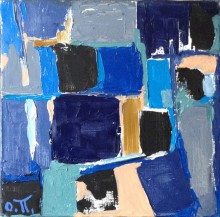It has become a good tradition for Olha Petrova to open exhibitions, which introduce another phase of her new achievements, in February, on her birthday (or close to that date). When observing this woman who, being full of youthful drive and creative enthusiasm, is an artist and a philosopher, a researcher and a writer, an art critic and a journalist, I am astounded by her extraordinary productivity, love for life, and desire for discoveries, the acquisition of new knowledge and new experiences. All this comes out through new books and research papers, paintings and articles, talented students and exhibitions. All this endlessly pleases her fans, both in Ukraine and far beyond its borders.
The conceptual foundations of the classical avant-garde, with Franz Marc and Wassily Kandinsky rightly considered its founding fathers, show that this art school develops on the principle of a decisive refusal to “copy” nature and engage in naturalism. Everyone can see the world around them, but the artist creates their own reality by abstracting from it.
Non-figurative paintings in Petrova’s exhibition “Wordless. The Primal Elements” testify to the invincible desire to escape from the material world and go on spiritual quests, to create one’s own world, in which everyone who looks at the picture opens their own “third eye” and finds a new emotional harmony.
The exhibition brought together works of different years, ranging from 1996 to 2018. For instance, Revival, painted in 1996, is permeated with a light of hope. Meanwhile, in Blue-III, the incongruence of dissimilar, awkward figures is “depressed” by heavy, dark cadmium.
“For an adequate perception of the non-figurative art (‘wordless’ compositions),” Petrova said, “it is especially important to rely on the spectator’s culture of attentive listening, their intuitive comprehension of the work as a message. This dialog between the spectator and the work offers a precious opportunity of understanding the two individualities: the author’s and the recipient’s. Kandinsky believed that dialog is important provided that the ‘desire to say’ something with an artwork meets the love-enlightened desire to ‘hear’ it, because ‘in and of itself, the explanation is unable to bring the individual closer to the non-figurative art.’”








